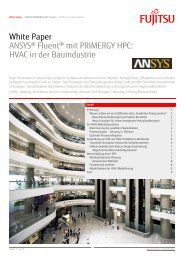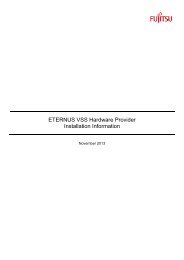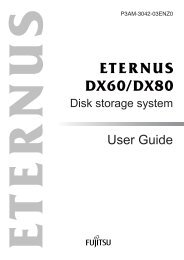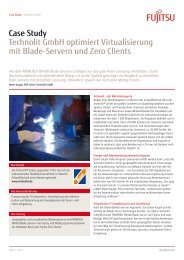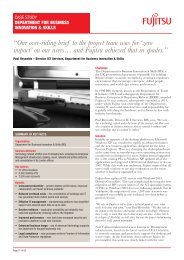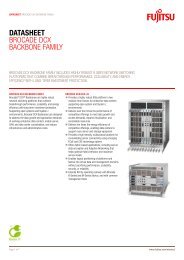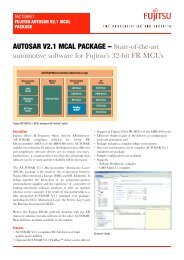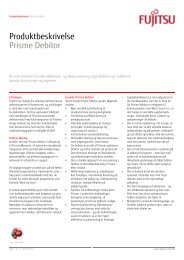- Page 1:
FUJITSU MICROELECTRONICS CONTROLLER
- Page 5 and 6:
PREFACE ■ Objectives and Intended
- Page 7 and 8:
CONTENTS PART I LINKAGE KIT .......
- Page 9 and 10:
6.2.7 Specification to fill ROM are
- Page 11 and 12:
CHAPTER 10 OPTIONS OF A LIBRARIAN .
- Page 13:
APPENDIX ..........................
- Page 16 and 17:
2 PART I LINKAGE KIT
- Page 18 and 19:
CHAPTER 1 SPECIFICATIONS OF LINKAGE
- Page 20 and 21:
CHAPTER 1 SPECIFICATIONS OF LINKAGE
- Page 22 and 23:
CHAPTER 1 SPECIFICATIONS OF LINKAGE
- Page 24 and 25:
CHAPTER 1 SPECIFICATIONS OF LINKAGE
- Page 26 and 27:
CHAPTER 1 SPECIFICATIONS OF LINKAGE
- Page 28 and 29:
CHAPTER 1 SPECIFICATIONS OF LINKAGE
- Page 30 and 31:
CHAPTER 1 SPECIFICATIONS OF LINKAGE
- Page 32 and 33:
CHAPTER 1 SPECIFICATIONS OF LINKAGE
- Page 34 and 35:
CHAPTER 1 SPECIFICATIONS OF LINKAGE
- Page 36 and 37:
CHAPTER 2 OPTIONS 2.1 Option An opt
- Page 38 and 39:
CHAPTER 2 OPTIONS 2.3 Notes and Eva
- Page 40 and 41:
CHAPTER 2 OPTIONS 2.5 Example of Sp
- Page 42 and 43:
CHAPTER 3 COMMON OPTIONS 3.1 List o
- Page 44 and 45:
CHAPTER 3 COMMON OPTIONS 3.2.1 Spec
- Page 46 and 47:
CHAPTER 3 COMMON OPTIONS For exampl
- Page 48 and 49:
CHAPTER 3 COMMON OPTIONS 3.2.4 Spec
- Page 50 and 51:
CHAPTER 3 COMMON OPTIONS 3.2.6 Spec
- Page 52 and 53:
CHAPTER 3 COMMON OPTIONS 3.2.8 Spec
- Page 54 and 55:
CHAPTER 3 COMMON OPTIONS 40 PART I
- Page 56 and 57:
CHAPTER 4 OPTION FILES 4.1 Outline
- Page 58 and 59:
CHAPTER 4 OPTION FILES 4.3 Specifyi
- Page 60 and 61:
CHAPTER 4 OPTION FILES 4.5 Default
- Page 62 and 63:
CHAPTER 4 OPTION FILES 48 PART I LI
- Page 64 and 65:
50 PART II LINKER
- Page 66 and 67:
CHAPTER 5 SPECIFICATIONS OF A LINKE
- Page 68 and 69:
CHAPTER 5 SPECIFICATIONS OF A LINKE
- Page 70 and 71:
CHAPTER 5 SPECIFICATIONS OF A LINKE
- Page 72 and 73:
CHAPTER 5 SPECIFICATIONS OF A LINKE
- Page 74 and 75:
CHAPTER 5 SPECIFICATIONS OF A LINKE
- Page 76 and 77:
CHAPTER 5 SPECIFICATIONS OF A LINKE
- Page 78 and 79:
CHAPTER 5 SPECIFICATIONS OF A LINKE
- Page 80 and 81:
CHAPTER 5 SPECIFICATIONS OF A LINKE
- Page 82 and 83:
CHAPTER 5 SPECIFICATIONS OF A LINKE
- Page 84 and 85:
CHAPTER 5 SPECIFICATIONS OF A LINKE
- Page 86 and 87:
CHAPTER 5 SPECIFICATIONS OF A LINKE
- Page 88 and 89:
CHAPTER 5 SPECIFICATIONS OF A LINKE
- Page 90 and 91:
CHAPTER 5 SPECIFICATIONS OF A LINKE
- Page 92 and 93:
CHAPTER 5 SPECIFICATIONS OF A LINKE
- Page 94 and 95:
CHAPTER 5 SPECIFICATIONS OF A LINKE
- Page 96 and 97:
CHAPTER 5 SPECIFICATIONS OF A LINKE
- Page 98 and 99:
CHAPTER 5 SPECIFICATIONS OF A LINKE
- Page 100 and 101:
CHAPTER 5 SPECIFICATIONS OF A LINKE
- Page 102 and 103:
CHAPTER 5 SPECIFICATIONS OF A LINKE
- Page 104 and 105:
CHAPTER 5 SPECIFICATIONS OF A LINKE
- Page 106 and 107:
CHAPTER 6 LINKER OPTIONS 6.1 List o
- Page 108 and 109:
CHAPTER 6 LINKER OPTIONS Table 6.1-
- Page 110 and 111:
CHAPTER 6 LINKER OPTIONS 6.2.1 Outp
- Page 112 and 113:
CHAPTER 6 LINKER OPTIONS 6.2.3 Debu
- Page 114 and 115:
CHAPTER 6 LINKER OPTIONS 6.2.5 Spec
- Page 116 and 117:
CHAPTER 6 LINKER OPTIONS 6.2.7 Spec
- Page 118 and 119:
CHAPTER 6 LINKER OPTIONS 6.2.8 Spec
- Page 120 and 121:
CHAPTER 6 LINKER OPTIONS 6.2.10 Map
- Page 122 and 123:
CHAPTER 6 LINKER OPTIONS 6.2.12 Can
- Page 124 and 125:
CHAPTER 6 LINKER OPTIONS 6.2.14 Dis
- Page 126 and 127:
CHAPTER 6 LINKER OPTIONS 6.2.16 Spe
- Page 128 and 129:
CHAPTER 6 LINKER OPTIONS 6.2.18 Che
- Page 130 and 131:
CHAPTER 6 LINKER OPTIONS [Example 2
- Page 132 and 133:
CHAPTER 6 LINKER OPTIONS [Example 5
- Page 134 and 135:
CHAPTER 6 LINKER OPTIONS 6.2.20 ROM
- Page 136 and 137:
CHAPTER 6 LINKER OPTIONS 6.2.22 Sec
- Page 138 and 139:
CHAPTER 6 LINKER OPTIONS 6.2.23 Sec
- Page 140 and 141:
CHAPTER 6 LINKER OPTIONS 6.2.25 Aut
- Page 142 and 143:
CHAPTER 6 LINKER OPTIONS 6.2.26 Ret
- Page 144 and 145:
CHAPTER 6 LINKER OPTIONS 6.2.28 Lib
- Page 146 and 147:
CHAPTER 6 LINKER OPTIONS 6.2.30 Spe
- Page 148 and 149:
CHAPTER 6 LINKER OPTIONS 6.2.32 Dum
- Page 150 and 151:
CHAPTER 6 LINKER OPTIONS 6.2.34 Spe
- Page 152 and 153:
CHAPTER 6 LINKER OPTIONS • When -
- Page 154 and 155:
CHAPTER 6 LINKER OPTIONS 6.2.37 Fun
- Page 156 and 157:
CHAPTER 6 LINKER OPTIONS 6.2.39 Use
- Page 158 and 159:
CHAPTER 6 LINKER OPTIONS 6.2.40 Use
- Page 160 and 161:
CHAPTER 6 LINKER OPTIONS Section ty
- Page 162 and 163:
CHAPTER 6 LINKER OPTIONS 6.2.42 Sec
- Page 164 and 165:
CHAPTER 6 LINKER OPTIONS 6.2.44 Sup
- Page 166 and 167:
CHAPTER 6 LINKER OPTIONS 6.2.46 Spe
- Page 168 and 169:
CHAPTER 6 LINKER OPTIONS 6.2.48 Spe
- Page 170 and 171: CHAPTER 6 LINKER OPTIONS 6.2.50 Spe
- Page 172 and 173: CHAPTER 6 LINKER OPTIONS 6.2.52 Spe
- Page 174 and 175: CHAPTER 6 LINKER OPTIONS 6.2.54 Spe
- Page 176 and 177: CHAPTER 6 LINKER OPTIONS 6.2.56 Spe
- Page 178 and 179: CHAPTER 6 LINKER OPTIONS 6.2.58 Spe
- Page 180 and 181: CHAPTER 6 LINKER OPTIONS 6.2.60 Spe
- Page 182 and 183: CHAPTER 6 LINKER OPTIONS 6.2.62 Spe
- Page 184 and 185: CHAPTER 6 LINKER OPTIONS 170 PART I
- Page 186 and 187: CHAPTER 7 OUTPUT LIST FILE OF THE L
- Page 188 and 189: CHAPTER 7 OUTPUT LIST FILE OF THE L
- Page 190 and 191: CHAPTER 7 OUTPUT LIST FILE OF THE L
- Page 192 and 193: CHAPTER 7 OUTPUT LIST FILE OF THE L
- Page 194 and 195: CHAPTER 7 OUTPUT LIST FILE OF THE L
- Page 196 and 197: CHAPTER 7 OUTPUT LIST FILE OF THE L
- Page 198 and 199: CHAPTER 7 OUTPUT LIST FILE OF THE L
- Page 200 and 201: CHAPTER 7 OUTPUT LIST FILE OF THE L
- Page 202 and 203: CHAPTER 7 OUTPUT LIST FILE OF THE L
- Page 204 and 205: CHAPTER 7 OUTPUT LIST FILE OF THE L
- Page 206 and 207: CHAPTER 7 OUTPUT LIST FILE OF THE L
- Page 208 and 209: CHAPTER 7 OUTPUT LIST FILE OF THE L
- Page 210 and 211: CHAPTER 7 OUTPUT LIST FILE OF THE L
- Page 212 and 213: CHAPTER 7 OUTPUT LIST FILE OF THE L
- Page 214 and 215: CHAPTER 8 LINKER RESTRICTIONS AND Q
- Page 216 and 217: CHAPTER 8 LINKER RESTRICTIONS AND Q
- Page 218 and 219: 204 PART III LIBRARIAN
- Page 222 and 223: CHAPTER 9 SPECIFICATIONS OF A LIBRA
- Page 224 and 225: CHAPTER 9 SPECIFICATIONS OF A LIBRA
- Page 226 and 227: CHAPTER 9 SPECIFICATIONS OF A LIBRA
- Page 228 and 229: CHAPTER 9 SPECIFICATIONS OF A LIBRA
- Page 230 and 231: CHAPTER 9 SPECIFICATIONS OF A LIBRA
- Page 232 and 233: CHAPTER 9 SPECIFICATIONS OF A LIBRA
- Page 234 and 235: CHAPTER 10 OPTIONS OF A LIBRARIAN 1
- Page 236 and 237: CHAPTER 10 OPTIONS OF A LIBRARIAN 1
- Page 238 and 239: CHAPTER 10 OPTIONS OF A LIBRARIAN 1
- Page 240 and 241: CHAPTER 10 OPTIONS OF A LIBRARIAN 1
- Page 242 and 243: CHAPTER 10 OPTIONS OF A LIBRARIAN 1
- Page 244 and 245: CHAPTER 10 OPTIONS OF A LIBRARIAN 1
- Page 246 and 247: CHAPTER 10 OPTIONS OF A LIBRARIAN 1
- Page 248 and 249: CHAPTER 10 OPTIONS OF A LIBRARIAN 1
- Page 250 and 251: CHAPTER 10 OPTIONS OF A LIBRARIAN 1
- Page 252 and 253: CHAPTER 10 OPTIONS OF A LIBRARIAN 1
- Page 254 and 255: CHAPTER 10 OPTIONS OF A LIBRARIAN [
- Page 256 and 257: CHAPTER 11 LIST FORMATS OF A LIBRAR
- Page 258 and 259: CHAPTER 11 LIST FORMATS OF A LIBRAR
- Page 260 and 261: CHAPTER 11 LIST FORMATS OF A LIBRAR
- Page 262 and 263: CHAPTER 12 RESTRICTIONS AND QUESTIO
- Page 264 and 265: CHAPTER 12 RESTRICTIONS AND QUESTIO
- Page 266 and 267: 252 PART IV OBJECT FORMAT CONVERTER
- Page 268 and 269: CHAPTER 13 SPECIFICATIONS OF AN OBJ
- Page 270 and 271:
CHAPTER 13 SPECIFICATIONS OF AN OBJ
- Page 272 and 273:
CHAPTER 13 SPECIFICATIONS OF AN OBJ
- Page 274 and 275:
CHAPTER 14 COMMON OPTIONS OF AN OBJ
- Page 276 and 277:
CHAPTER 14 COMMON OPTIONS OF AN OBJ
- Page 278 and 279:
CHAPTER 14 COMMON OPTIONS OF AN OBJ
- Page 280 and 281:
CHAPTER 15 LOAD MODULE CONVERTER (f
- Page 282 and 283:
CHAPTER 15 LOAD MODULE CONVERTER (f
- Page 284 and 285:
CHAPTER 15 LOAD MODULE CONVERTER (f
- Page 286 and 287:
CHAPTER 15 LOAD MODULE CONVERTER (f
- Page 288 and 289:
CHAPTER 15 LOAD MODULE CONVERTER (f
- Page 290 and 291:
CHAPTER 15 LOAD MODULE CONVERTER (f
- Page 292 and 293:
CHAPTER 15 LOAD MODULE CONVERTER (f
- Page 294 and 295:
CHAPTER 16 FORMAT ADJUSTER (m2ms, h
- Page 296 and 297:
CHAPTER 16 FORMAT ADJUSTER (m2ms, h
- Page 298 and 299:
CHAPTER 16 FORMAT ADJUSTER (m2ms, h
- Page 300 and 301:
CHAPTER 16 FORMAT ADJUSTER (m2ms, h
- Page 302 and 303:
CHAPTER 16 FORMAT ADJUSTER (m2ms, h
- Page 304 and 305:
CHAPTER 16 FORMAT ADJUSTER (m2ms, h
- Page 306 and 307:
CHAPTER 17 BINARY CONVERTER (m2bs,
- Page 308 and 309:
CHAPTER 17 BINARY CONVERTER (m2bs,
- Page 310 and 311:
CHAPTER 17 BINARY CONVERTER (m2bs,
- Page 312 and 313:
CHAPTER 17 BINARY CONVERTER (m2bs,
- Page 314 and 315:
CHAPTER 17 BINARY CONVERTER (m2bs,
- Page 316 and 317:
CHAPTER 18 OTHER CONVERTERS 18.1 m2
- Page 318 and 319:
CHAPTER 18 OTHER CONVERTERS 18.3 i2
- Page 320 and 321:
CHAPTER 18 OTHER CONVERTERS 306 PAR
- Page 322 and 323:
CHAPTER 19 RESTRICTIONS AND QUESTIO
- Page 324 and 325:
CHAPTER 19 RESTRICTIONS AND QUESTIO
- Page 326 and 327:
APPENDIX APPENDIX A ERROR MESSAGES
- Page 328 and 329:
APPENDIX ■ Error Messages of the
- Page 330 and 331:
APPENDIX W1303L Section with initia
- Page 332 and 333:
APPENDIX W1325L Entry point already
- Page 334 and 335:
APPENDIX W1372L The section is plac
- Page 336 and 337:
APPENDIX E4329L Value out of range
- Page 338 and 339:
APPENDIX E4362L DUMMY section speci
- Page 340 and 341:
APPENDIX F9001L Insufficient memory
- Page 342 and 343:
APPENDIX F9026L Specified value out
- Page 344 and 345:
APPENDIX F9053L Missing '-ro’ or
- Page 346 and 347:
APPENDIX I0401U Reference to undefi
- Page 348 and 349:
APPENDIX W1406U Module not exists t
- Page 350 and 351:
APPENDIX E4470U CPU information fil
- Page 352 and 353:
APPENDIX F9033U Illegal file format
- Page 354 and 355:
APPENDIX ■ Error Messages of the
- Page 356 and 357:
APPENDIX F9023U Illegal option para
- Page 358 and 359:
APPENDIX F9049U Output range exceed
- Page 360 and 361:
APPENDIX B.1 Common Format The HEX
- Page 362 and 363:
APPENDIX B.2 Data Record (HEX8/HEX1
- Page 364 and 365:
APPENDIX B.4 Extended Segment Addre
- Page 366 and 367:
APPENDIX B.6 Extended Linear Addres
- Page 368 and 369:
APPENDIX APPENDIX C S RECORD FORMAT
- Page 370 and 371:
APPENDIX C.2 S1 Type (Data Record:
- Page 372 and 373:
APPENDIX C.4 S3 Type (Data Record:
- Page 374 and 375:
APPENDIX C.6 S7 Type (Terminator Re
- Page 376 and 377:
APPENDIX C.8 S9 Type (Terminator Re
- Page 378 and 379:
APPENDIX Table D-1 List of Linker O
- Page 380 and 381:
APPENDIX APPENDIX E LIST OF LIBRARI
- Page 382 and 383:
APPENDIX ■ List of options of the
- Page 384 and 385:
APPENDIX 370
- Page 386 and 387:
Index Checking Checking the Content
- Page 388 and 389:
Index f2hs f2hs (Converting an Abso
- Page 390 and 391:
Index Example of a Search when ther
- Page 392 and 393:
Index -mlf Specification for Sectio
- Page 394 and 395:
Index Specifies to Prevent the Inte
- Page 396 and 397:
Index Entry Address Specification (
- Page 398 and 399:
Index Types of Section Contents....
- Page 400 and 401:
Index 386



